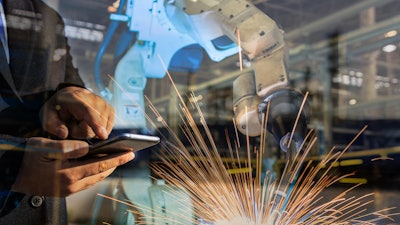
We are witnessing a digital age where virtual and physical worlds are converging and revolutionizing the landscape of many industries. In what has become the “new normal,” industrial manufacturers are realizing large productivity gains by leveraging extended reality (XR) technologies to support digital manufacturing. According to IDC, worldwide spending on augmented reality (AR) and virtual reality (VR) is expected to grow to $72.8 billion by 2024, - those forecast to receive the largest investments are training and industrial maintenance.
Adopting these new technologies can help manufacturers not only navigate the current pandemic crisis, but also enable them to be more agile and productive post-pandemic as they enable the factory of the future.
Unanticipated disruptive events like COVID-19 have made the digital thread more important than ever before. The digital thread enables a seamless data flow throughout the organization, which leads to improvements and benefits throughout the entire operation. The focal point of the digital thread is the digital twin, or the virtual representation of the physical product or environment.
Extended reality is the visualization and enablement component of a digital thread that brings digital information into view for product manufacturing, user training and service value chain by leveraging 3D geometry, audio, video, text and other media from multiple sources, at any point in the product lifecycle – design, testing, quality assurance, manufacturing and after product launch.
Extended reality is a key enabler of digital transformation. As part of a connected enterprise, extended reality uses a mix of wearable and handheld augmented reality (AR), mixed reality (MR), spatial computing and virtual reality (VR) tools to overlay additional digital information into how work gets done.
Here are a few ways industrial organizations can leverage XR to achieve greater efficiency, accuracy, and productivity for their workforces.
Work Instructions
Capturing worker knowledge and sharing it across the enterprise is an essential part of maintaining a productive workforce. While knowledge transfer starts with the documentation of work instructions, it heavily relies on an effective capture and delivery for the transfer to be successful. XR tools can be beneficial in helping employees working on plant floor cells to assemble components correctly and in the right order. As a result, manufacturers can increase worker productivity and improve the speed and accuracy in complex assemblies or production lines.
Remote Service
Service calls and visits have become increasingly complex as assets with more technological and digital elements are deployed with the customer. Remote services produce benefits for both manufacturers and their customers, and in the aftermath of COVID-19, this way of working has even greater appeal. Employing XR technologies, such as augmented or virtual interactive experiences, can enable field service teams to provide on-demand expertise through remote assistance through tablets or devices in certain scenarios.
XR can allow a product to be identified in the field, to gather and provide information, and execute activities related to that product. This helps to ensure effectiveness of service and shared visibility together with employee safety.
Immersive Product Experiences
XR eliminates the requirement for sales professionals to enter their customers’ sites by providing a virtual product demonstration. It can be used to simulate the spatial configuration via digital twin and user experiences through a headset display of products even without their physical presence – enabling faster business investment evaluations and early validation of project development.
Collaboration
Digital twins play an important role in extended reality. Using XR tools, multiple users can visualize and interact with a product’s digital twin in a real or virtual environment on physical or holographic prototypes. For example, workers can come together in a virtual reality environment to test a product’s fit on a pallet or store shelf. Workers can also use augmented reality to better understand machinery processes and conduct maintenance checks from a remote location using digital twin technology.
In summary, companies that implement XR into their digital transformation strategies can boost workforce efficiency and safety, improve operational performance and productivity, and lower costs across the factory and the field.
Dave Hadfield is the Director of Life Sciences at Kalypso.






















